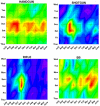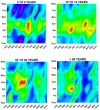Temporal variation in United States firearm injuries 1993-2008: results from a national data base
- PMID: 23669603
- PMCID: PMC3865450
- DOI: 10.5249/jivr.v6i1.351
Temporal variation in United States firearm injuries 1993-2008: results from a national data base
Abstract
Background: There are few studies that address temporal variation in firearm associated injuries. It was the purpose of this study to analyze the temporal variation in the types and patterns of injuries associated with firearm use from a national data base.
Methods: The database used was the Inter-University Consortium for Political and Social Research Firearm Injury Surveillance Study 1993-2008. Emergency department visits associated with firearm use were analyzed for month and day of the week for various demographic variables. Statistical analyses were performed using SUDAAN 10™ software to give national estimates. Temporal variation by month or day was assessed using histograms, circular distributions, and cosinor analyses. Variation by month and day combined were analyzed using three dimensional contours.
Results: There were an estimated 1,841,269 injuries. Circular analyses demonstrated a non-uniform distribution for all parameters for both month and day of injury (p less than 0.001). The overall peak was September 15 with several exceptions. Injuries from BB guns had a peak on May 22, a diagnosis of a foreign body on July 11, and patients aged 10 to 14 years on April 9.The peak day was always Saturday/Sunday when significant variation existed. There were many different patterns for month and day combined. Some were "a rapidly rising high mountain starting at sea level" (hunting), or others a "series of mountain ranges starting from a high plain or steppe" (hospital admissions).
Conclusions: This study provides altogether new information regarding temporal variation for injuries associated with firearms in the USA. These results can be used to assist medical resource allocation and prevention campaigns. Education campaigns can be emphasized before the peaks for which prevention is desired (eg. BB gun prevention campaigns should be concentrated in March, prior to the April/May peak).
© 2014 KUMS, All rights reserved.
Figures















References
-
- Ary RD, Waldrop RD, Harper DE. The increasing burden of pediatric firearm injuries on the emergency department. Pediatr Emerg Care. 1996 Dec;12(6):391–3. - PubMed
-
- Zautcke JL, Morris RW, Koenigsberg M, Carmody T, Stein-Spencer L, Erickson TB. Assaults from penetrating trauma in the state of lllinois. Am J Emerg Med. 1998 Oct;16(6):553–6. - PubMed
-
- Blumenthal R. Suicidal gunshot wounds to the head: a retrospective review of 406 cases. Am J Forensic Med Pathol. 2007 Dec;28(4):288–91. - PubMed
-
- Mattila VM, Mäkitie I, Pihlamamäki H. Trends in hospitalization for firearm-related injury in Finland from 1990 to 2003. J Trauma. 2006 Nov;61(5):1222–7. - PubMed
Publication types
MeSH terms
LinkOut - more resources
Full Text Sources
Other Literature Sources
Miscellaneous

